The Iraq War was a protracted armed conflict that began in 2003 when a US-led coalition invaded Iraq and toppled Saddam Hussein's Ba'athist dictatorship. During the ensuing decade, an insurgency emerged to oppose the Coalition forces and the new Iraqi government, leading to the emergence of al-Qaeda in Iraq, which would later become the Islamic State. Most of the Coalition forces had withdrawn by 2009, with just the US and British forces remaining in the country to support the Iraqi government against the insurgency. Caught in an unwinnable war, the new US president Barack Obama decided to gradually withdraw US soldiers from the country, and British Prime Minister David Cameron did the same. By December 2011, the last of the Coalition forces had left the country, and the Iraqi government was left to fight the diminished insurgency on its own. Sporadic fighting continued until 2013, when the insurgency was revitalized by the election of an unpopular Shi'ite governnment under Nouri al-Maliki, leading to the outbreak of the Iraqi Civil War and the rise of the Islamic State in 2014. Ultimately, the Coalition countries were forced to return to Iraq as a result of the new war.
Background[]
The Ba'athist government of Iraq, led by Saddam Hussein, was in power since 1968. Saddam's rule was marked by the dominance of the Sunni Muslim minority of Iraq over the Shi'ite majority, as well as by Arab nationalism. During the Iran-Iraq War, Saddam failed to destroy the Iranian Revolution with military force, and the end of the war saw the Ba'athists launch a campaign of genocide against the rebellious Kurds in the al-Anfal Campaign.
In 1990, Saddam Hussein ordered his military to invade the small and oil-rich country of Kuwait to the south, as Iraq had been bankrupted by the war with Iran, and sought to seize Kuwait's oil fields. The United States, United Kingdom, Saudi Arabia, and France formed a coalition against Iraq after Saddam refused to withdraw his forces, and, within a week in February 1991, Saddam's forces were forced to retreat from Kuwait and into Iraq during the brief "Gulf War". The peace terms imposed upon Iraq included economic sanctions, enforced containment, and the creation of no-fly zones to prevent the Iraqi Air Force from bombing the rebellious Kurds and Shi'ites. Nevertheless, following the war's end, Kurdish and Shi'ite uprisings occurred, and, unsupported by the Coalition forces encamped in the Arabian desert, the uprisings were brutally suppressed.
From 1992 to 2003, the US, British, and French air forces enforced the no-fly zones in Operation Southern Watch, periodically bombing Iraq to punish Saddam for his attempts to betray the peace deal. Iraq was also suspected of possessing weapons of mass destruction (WMDs), and US president George W. Bush believed that Iraq posed an immediate threat to the US and its allies.
Following the 9/11 terrorist attacks of 11 September 2001, a wave of hysteria about the Middle East struck the United States, leading to the US-led invasion of Afghanistan that same year. Select US officials looked to Iraq, accusing Saddam Hussein of harboring and supporting al-Qaeda, the perpetrators of the attacks against the USA. In reality, Saddam Hussein was at odds with radical Islamism, as Ba'athism espoused an ideology of nationalism and secularism instead of Islamic unity and sharia law. In addition, al-Qaeda leader Osama Bin Laden had been sponsoring anti-Saddam Islamists in Iraqi Kurdistan, including the Kurdistan Islamic Group; however, it was suspected that Saddam supported Bin Laden's creation, Ansar al-Islam, against their common enemy, the Kurdish Peshmerga.
On 12 September 2002, President Bush addressed the United Nations Security Council and made his case for the need for an invasion of Iraq. France and Germany refused to support an invasion, as Bush refused to attempt diplomacy as a solution. However, the UN agreed to send inspectors to ensure that Iraq was not in possession of WMDs, and Hans Blix served as the chairman of this commission. In March 2003, Blix said that progress had been made in the inspections, and that no WMDs had been found. However, the US Congress had authorized military force against Iraq in October 2002, and, by February 2003, 64% of Americans supported military action against Iraq; 85% of the American public believed that Saddam possessed WMDs. On 5 February 2003, Secretary of State Colin Powell appeared before the UN to present evidence that Iraq was hiding unconventional weapons, using the testimony of Iraqi emigrant "Curveball" as evidence (these claims were later admitted to have been false). The USA, the United Kingdom, Poland, Italy, Australia, Denmark, Japan, and Spain proposed a resolution authorizing the use of force in Iraq, and an invasion force was assembled. This force consisted of 248,000 US, 45,000 British, 2,000 Australian, and 194 Polish soldiers. On 17 March 2003, Bush demanded that Saddam and his sons Qusay and Uday Hussein surrender and leave the country, giving them a 48-hour deadline. A day later, the British House of Commons voted in favor of authorizing military action.
War[]
Invasion[]
At 5:34 AM on 20 March 2003, the surprise military invasion of Iraq began. Coalition forces launched air and amphibious assaults on the al-Faw Peninsula to secure the oil fields and ports there, supported by the British, Australian, and Polish navies. US, British, and Polish forces attacked the port of Umm Qasr, and the heavy armor of the US 3rd Infantry Division moved from the western desert toward Baghdad as the British 1st Armored Division moved northward through the eastern marshland. The US 1st Marine Division fought through Nasiriyah, seizing the major road junction. The 3rd Infantry Division, supported by the US 101st Airborne Division, continued its attack toward Najaf and Karbala, and US forces poured through the gap to Baghdad. On 9 April 2003, Baghdad fell, and the US soldiers toppled the statue of Saddam in Firdos Square. The north of Iraq was pacified with the help of Kurdish Peshmerga forces, and the invasion ended with the fall of Tikrit, Saddam's birthplace, on 30 April. 9,200 Iraqi soldiers, 3,750 civilians, 139 US soldiers, and 33 British soldiers were killed during the invasion. On 1 May 2003, President Bush delivered his famous "Mission Accomplished" speech due to the defeat of Iraq's conventional army.
Insurgency - 2003[]
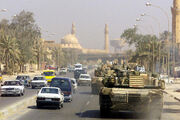
A US Marine Corps tank in Baghdad, April 2003
Despite the fall of Baghdad, Saddam Hussein remained at large and significant pockets of resistance remained. An insurgency, supplied by hundreds of weapons caches created before the invasion by the Iraqi Army and the Iraqi Republican Guard, grew out of the Sunni Triangle, the area between Tikrit to the north, Ramadi to the southwest, and Baghdad to the southeast. The insurgents used mortars, missiles, suicide attacks, IEDs, car bombs, small arms fire, RPGs, and sabotage against the occupiers, and they launched the "Ramadan Offensive" against the occupiers in October-November 2003.
On 22 July 2003, Uday and Qusay Hussein were killed in a raid by the 101st Airborne Division, and Saddam himself was captured on a farm near Tikrit on 13 December 2003. Shortly after Saddam's capture, the Coalition established an Iraqi provisional government, which was dominated by the Shi'ite majority of the country, a group which had been oppressed during Saddam's rule.
2004[]
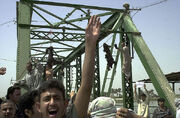
The hanging bodies of the killed contractors at Fallujah
On 31 March 2004, the world was shocked when news agencies released photos of the burned corpses of four US private military contractors being hung over a bridge crossing on the Euphrates. This prompted the US forces to launch an attempt to pacify the city of Fallujah, where the contractors had been killed, and the First Battle of Fallujah in April 2004 failed to recapture the city. In November 2004, the bloodiest battle of the war was fought, the Second Battle of Fallujah. In the heaviest urban combat seen by the US military since the Battle of Hue during the Vietnam War, the US used white phosphorus against the insurgents, and they fought for control of the city for 46 days. 95 US soldiers and 1,350 insurgents were killed, and the city was totally devastated during the fighting. That same year, the Abu Ghraib prisoner abuse scandal became public, as the international media discovered that the US had been using torture against suspected terrorists at the Abu Ghraib prison, dealing a blow to the moral justifications of the war.
2004 also saw the rise of al-Qaeda in Iraq (AQI). al-Qaeda had barely any presence in Iraq before the war, but al-Qaeda took advantage of growing sectarian tensions and opposition to foreign occupation to establish a support base in Iraq. The 250,000-strong Iraqi Army was disbanded following the invasion, and many of these unemployed former soldiers decided to join the insurgency. In addition, Sunni extremist clerics began to spread Islamism across the country, motivating many young men to join the jihad against the occupying forces. Abu Musab al-Zarqawi, a Jordanian al-Qaeda member, became the leader of AQI, which came to be the largest group in the insurgency.
2005[]
In 2005, a Transitional Government was elected to draft a permanent constitution, and the first few months of the year were relatively peaceful. However, in April 2005, the insurgents attacked the Abu Ghraib prison in the largest coordinated attack against a US base since Vietnam. In the summer, the US attempted to seal off the Syrian border, leading to heavy fighting with the insurgency. On 15 October 2005, the new Iraqi constitution was ratified.
2006[]
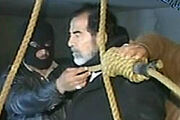
Saddam before being hanged
The election of a predominantly Shia and Kurdish government alienated the Sunnis, and sectarian violence broke out between Sunnis and Shi'ites. Sunni and Shia extremist militant groups were formed, and they carried out terrorist attacks against each other's civilian populations, as well as against their common enemy, the foreign occupiers. The daily homicide rate in Iraq tripled from 11 to 33 as the result of the bombing of a major Shi'ite mosque in Samarra. Extremist Shia clerics, backed by Iran's IRGC, created Shi'ite "Special Groups" to fight against both the Sunni extremists and against the occupiers; meanwhile, Sunni militias such as Hamas of Iraq and the 1920 Revolution Brigade were formed to fight against the Shi'ite government and militias, the US occupation forces, and the al-Qaeda extremists. On 6 June 2006, al-Zarqawi was killed in an airstrike on his compound in Baqubah, and, on 30 December 2006, Saddam was hanged after being found guilty of crimes against humanity.
2007[]
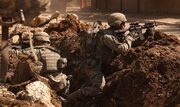
US troops in al-Doura, Baghdad, 2007
On 10 January 2007, President Bush announced a "troop surge" of 21,500 more soldiers to Iraq, believing that this would lead to the crushing of the insurgency. David Petraeus was sent to command the Coalition forces in February. 2007 was one of the deadliest years of the war, with a series of coordinated suicide bombings in Kahtaniya on 14 August 2007 killing nearly 800 civilians. On 13 September, US ally and pro-government militia leader Abdul Sattar Abu Risha was killed in a suicide bombing in Ramadi. The US forces had another public relations disaster when their Blackwater mercenaries killed eight civilians, including a woman and an infant, in a firefight in Baghdad.
That year, the Iraqi Parliament asked the US government to set a timetable for the withdrawal of the Coalition forces. Prime Minister Tony Blair announced that British troops would begin to withdraw from Basra and turn over the area to the Iraqi military, while 441 Danish troops were withdrawn; only 9 Danish soldiers were left behind to man four observational helicopters. On 13 September 2007, Bush backed a limited withdrawal of troops from Iraq, and 5,700 troops were withdrawn by Christmas.
2008[]
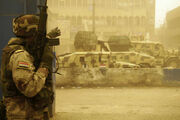
The fighting in Sadr City, 2008
By early 2008, the violence in Iraq had drastically decreased, dropping by 80%; the US casualty rate dropped from 904 in 2007 to 314 in 2008. In the spring, the Iraqi military finally took action against the Shia militias, which Prime Minister Nouri al-Maliki had allowed to operate due to their opposition to the Sunnis, and the British helped the Iraqi government to pacify the city of Basra. The British bragged that they had secured Basra and limited its murder rate to that of their city of Manchester. By 2008, Iran had also decreased the amount of explosives supplied to the Shi'ite militias, possibly reflecting a policy change. In May, the Iraqi army launched an assault on al-Qaeda's last stronghold, Mosul, but the city remained a major flashpoint by the year's end. 10,000 Turkish soldiers launched a 25-kilometer-deep invasion of northern Iraq, but they withdrew on 29 February.
On 31 March 2008, the Shi'ite religious leader Muqtada al-Sadr ordered his followers to ceasefire during the Iraqi Army's spring offensive against the Shia militants, and government soldiers took over the Islamic militants' headquarters in Basra, as well as pacifying the Sadr City section of Baghdad. That same year, the US began selling more military equipment to the Iraqi military, preparing them for the eventual US withdrawal.
2009[]
On 1 January 2009, the US government handed over control of the "Green Zone" in Baghdad to the Iraqi government as a symbolic restoration of Iraq's sovereignty. On 27 February, the new US president Barack Obama announced that the US combat mission in Iraq would end by 31 August 2010. A transitional force of up to 50,000 troops would remain behind until the end of 2011, conducting counterterrorism operations and training the Iraqi security forces. On 30 April, the British formally ended combat operations and turned over Basra to the Americans. On 29 June, US forces withdrew from Baghdad, and, on 28 July, Australia withdrew its combat forces. By the year's end, of the original Coalition, only the US forces remained the country.
2010[]
On 18 April 2010, all-Qaeda in Iraq leaders Abu Ayyub al-Masri and Abu Omar al-Baghdadi were killed in a joint US-Iraqi operation in Tikrit, during which ground forces surrounded the house and used missiles to assist in their attack. However, al-Qaeda launched bombings against Iraq's major banks in Baghdad, and, in late August 2010, 12 car bombings killed 51 Iraqis from Mosul to Basra. On 19 August 2010, the last US combat brigades departed from Iraq, but 50,000 troops remained in Iraq to support the military. In October, another crushing public relations disaster struck the USA when 391,832 classified documents about the Iraq War were leaked to the public by WikiLeaks. At the same time, hundreds of members of the Sons of Iraq anti-insurgent militias switched back to the insurgency and al-Qaeda.
2011[]
2011, the last year of the war, saw the last remaining US forces begin their withdrawal, despite being targeted in several terrorist attacks. On 21 October 2011, President Obama confirmed that all remaining US troops and trainers would leave Iraq as scheduled, and the last US soldier to be killed before the withdrawal died in a roadside bomb attack in Baghdad on 14 November. On 15 December 2011, an American military ceremony was held in Baghdad, putting a formal end to the US mission in Iraq. On 18 December, the last US troops withdrew, with 5,000 private contractors and a US Marine Corps contingent being left behind to guard the US embassy.
Aftermath[]
After the US military's withdrawal, Sunni militant groups stepped up attacks against the country's majority Shia population to undermine the government's attempts to protect its people without US backup. By 2013, there were fears that Iraq would return to its state of sectarian strife not seen since 2006. On 22 July 2013, 500 convicts, most of whom were senior al-Qaeda members on death row, broke out of Abu Ghraib jail after their comrades launched a military-style assault to free them, electrifying the Sunni population in Iraq. In 2014, these escaped convicts became the leaders of the new Islamic State of Iraq and Syria, which was formed by former AQI leader Abu Bakr al-Baghdadi as a combination of AQI fighters and al-Qaeda-affiliated militants who had been fighting in the Syrian Civil War. In June 2014, ISIS launched a sweeping offensive across northern Iraq, overwhelming cities such as Mosul and Tikrit, while the Kurds took over Kirkuk. The US was ultimately forced to return to Iraq to assist the Iraqi government during a new era of violence and war, the Iraqi Civil War.
